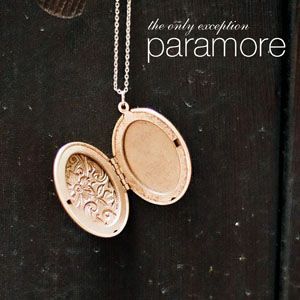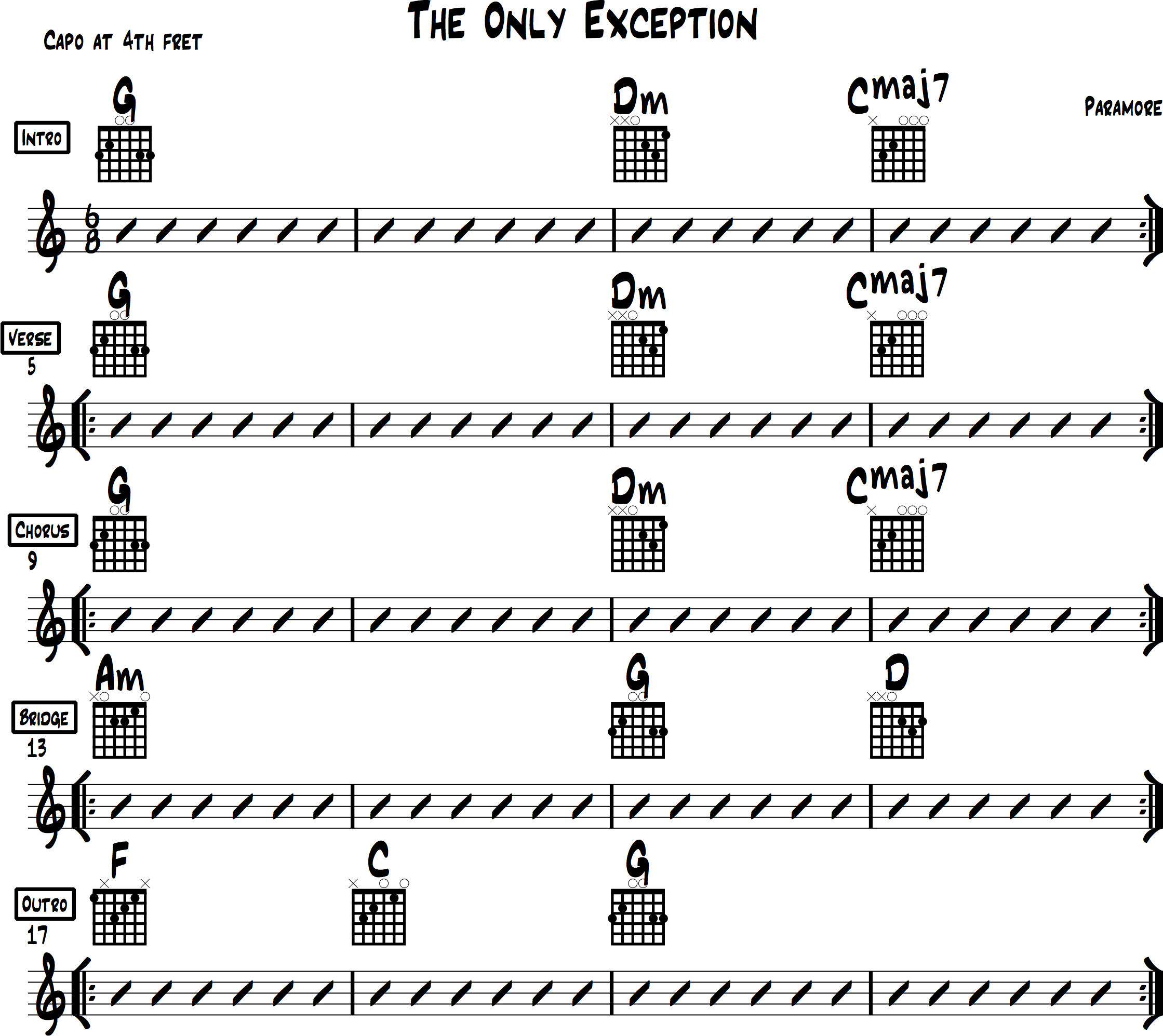Easy Guitar Chords Arranged for Beginners
American rock band, Paramore, released the song “The Only Exception” as the third single from the band’s third studio album, Brand New Eyes in 2009. The song was written by singer Hayley Williams and guitarist Josh Farro. Williams’ vocal performance was well received by music critics who also noted that “The Only Exception” was a departure for the band.
Paramore’s music style has generally been regarded as alternative rock, pop and emo. Singer Hayley Williams has also been compared to No Doubt, Kelly Clarkson and Avril Lavigne—partly due to Paramore being a female-fronted band. Their sound has been influenced by Fall Out Boy, Hanson, Panic! at the Disco, Blink-182, Death Cab for Cutie, Jimmy Eat World, and other post-90s bands.
Useful links:
Song Specs
 Title: The Only Exception
Title: The Only Exception
Artist: Paramore
Songwriters: Josh Farro / Hayley Williams
Album: Brand New Eyes
Key: G (capo at 4th fret)
Tempo: 48
Chord Progression: G–Dm–Cmaj7–Am–F–D
Accompaniment Technique: First-Position Chords and Fingerstyle Strumming
Playing Tips
Here are some helpful tips to keep in mind that will help you learn the tune faster while giving you some ideas for how to approach performing it. I provided some useful links above and I’ll take you through the chords, accompaniment patterns, song form and a chord chart. Everything you need to get started playing this tune.
The Only Exception Chords
| Chords | G | Dm | Cmaj7 | Am | F | D |
| Progression | i | v | IV | ii | bVII | V |

“The Only Exception” is a soulful acoustic number. We can use the acoustic guitar part on the recording as the template for our strumming pattern.
This song is mainly in the key of B (B Mixolydian to be precise). But, we’ll be using a capo at the 4th fret and thinking in the key of G (or G Mixolydian as we stated above). It’s just easier and sounds better this way. The Bridge is in A Dorian (a version of A minor) and the Outro is in F Lydian (a version of F major). We’ll discuss these in the video.
We’re also gonna approach this from a strumming standpoint. We’ll be using a pick and Josh Farro (the guitarist on this song) uses a pick. You can also use your fingers to strum (I’ll discuss this below) and they can provide you with more sound options. However, I do encourage to approach the song however you see fit and feel most comfortable. These are just my suggestions.
Accompaniment Techniques
I generally use four basic approaches to acoustic-guitar playing. They’re all based on a fingerstyle technique that I’ll describe below. But, the basic idea is that the thumb plays the bass note and the index and middle fingers brush the top part of the chord.
Here’s the basic technique that I use:
- Bass Chord: We separate the thumb and fingers to create more of a rhythmic feel. Aim to use the thumb on the downbeat and then freely strum with the index and middle fingers. I’ll explain this in more detail after we look at the next section.
Basic Fingerstyle Technique
“The Only Exception” is perfect for beginning fingerstyle players to strum. The right hand is notated as follows:
- P = Thumb
- I = Index
- M = Middle
- A = Ring
Next, you can assign the right-hand fingers to certain strings:
- The Thumb (P) plays the bass note:
- 6th string for G and F
- 5th string for Am and C
- 4th string for Dm and D
- The Index (I) is assigned to the 4th string.
- The Middle (M) is assigned to the 3rd string.
- The Ring (A) is assigned to the 2nd string.
- The I-M-A fingers will need to move up a string set for the Dm and D7 chords. Or, you could assign the I-M-A fingers to the 3rd, 2nd and 1st strings right from the beginning.
This is the essence of finger-style playing, assigning fingers to specific strings. This way, you don’t need to look at the right hand while playing. Once you get used to it, you can “feel” where you are.
The Boom-Chick Technique
“The Only Exception” uses an alternate (down and up) strumming technique and I’ll first describe it with a pick. Amongst guitarists, this technique is referred to as the boom-chicka pattern. Here’s the breakdown:
- The “boom” is the bass (lowest note of the chord) played with a downstrum
- The “chicka” is the higher part (the top 2 or 3 strings) of the chord also played with alternating strums (down followed by up)
- Downstrum on “chick” and the upstrum on “a”
There’s a boom-chick technique that is the basic version of the boom-chicka. And, the boom-chick only uses downstrums: bass-chord, bass-chord; or, boom-chick, boom-chick.
When hitting the bass (boom), you aim for the lower part of the chord (or the bottom three strings). Then, for the chord (chick), aim for the higher three strings.
Also, you don’t need to strum too hard. Brush the strings and try to recreate that bouncy feel that is a key component of the song.
The Fingerstyle Version of the Boom-Chicka Technique
The thumb (or P) plays the bass note (boom) and the I-M fingers brush down and up on the higher three strings creating the chick-a.
- “Boom, chicka, chicka” is the feel that you’re aiming for.
Chord Chart
I’ve included a chord chart, which is a simple road map that shows you:
- The overall arrangement of the song.
- A section by section breakdown of the song.
- Each chord and how long to play it for.
If you don’t read music, please don’t be intimidated. This is a cheat sheet that can help you get through the tune quickly and easily. I find it indispensable for learning songs and I can also hand it to a seasoned musician and they can follow along without any problems.
Song Form
- Intro: 4-bar section that repeats; Bars 1 & 2, G chord; Bar 3, the Dm; and, Bar 4, the Cmaj7.
- Verse: Same as Intro
- Chorus: Same as Intro and Verse.
- Bridge: 4-bar section that repeats; Bars 1 & 2, Am; Bar 3, F; and, Bar 4, D.
- Outro: 4-bar section that repeats; Bars 1, F; Bar 2, C; and, Bars 3 & 4, G.
Once you become familiar with chord charts, you’ll gonna never want to go back. It’s just easier to see where you’re going when you have a map. And, it’s especially helpful when you’re not familiar with the song or there’s a section of the song that you don’t remember (Bridges and Interludes are notorious for surprising players and derailing a song’s performance). So, heads up, this tune has a Bridge and an Outro where the progression changes.

Wrap-up
I hope that you’ve enjoyed learning The Only Exception chords as much as I did in preparing this lesson for you. During the intro for this piece I mentioned Hayley Williams’ influences. I encourage you to listen to those artists and discover where Williams gets her inspiration from. This tune is a beautiful piece of songwriting that has moments that seem, to me at least, to be inspired by traditional folk music.
Thanks for hangin’ with me and I’ll see you next time!







